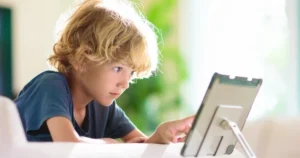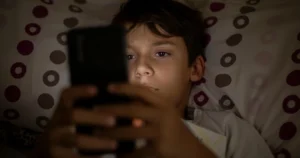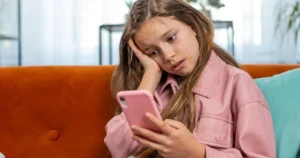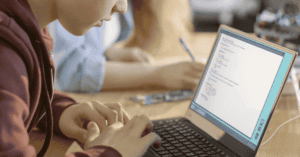A child who is victim to child-on-child sexual abuse or grooming from an adult may send sexts or nudes. There could be many reasons why they do this.
Our expert panel provides insight and more about the law, sexting and tips to manage the situation.
If my child is caught sexting by the school, what is the expected procedure?
There are a lot of “depends” in relation to young people and ‘sexting’.
The school should have a formal procedure for dealing with sexting and sharing inappropriate content, so it’s important to ask the school for this.
Most schools will also make a judgement on whether to involve outside agencies (such as the police), but it is important that parents are involved in the discussions and whether support, further education or punishment is most appropriate.
Each sexting incident is different, and it is important that schools deal with them appropriately on a case-by-case basis.
Will this be kept on a child’s record?
This is down to a) whether the school chooses to involve the police and b) whether the police decide it is in the public interest to record the incident as a crime (or, in serious cases, move to prosecute).
The police have the option to record an incident as “Outcome 21”, which makes a note of it taking place but not putting it on criminal record. Many sexting incidents are now dealt with in this way.
However, for more serious incidents (for example, deliberately sharing an image to abuse, coerce or exploit the victim) prosecution may still take place.
Learn more about child-on-child abuse here.
How will a school react to cases of sexting?
Policies regarding sexting vary slightly from school to school, and so do the exact procedure according to the individuals involved, the age and context.
For the school to be aware that incidents of sexting has taken place – probably a tiny fraction of the actual number – there are probably wider issues such as subsequent sharing and bullying, a distressed response to unsolicited images or a parent alerting the school after monitoring their child’s social media use.
The latter is the least likely, as most sexual images are shared via social media. Apps like Snapchat, which might be used, limit the time of visibility.
School pastoral or safeguarding staff will usually meet with all of the parties who are involved in the sexting. This might mean sharing information with equivalent staff at another school, should one of the young people attend a different setting.
Assessing the situation
The staff members will interview the students and ascertain if there has been any coercion involved in obtaining the image as well as assessing age difference and whether there is a bullying or abusive dimension to the incident.
Parent involvement
Parents will usually be contacted and all of the involved parties will be required to remove the image from their devices. Whilst it is illegal for any child under the age of 18 to make, send, share or request an explicit image, younger children may, of course, need additional support from counselling services, the police or social services.
Most professionals would be in agreement that it is not in the best interests of a child to criminalise them for sending a sexual image, despite the fact that the age of criminal responsibility is 10 years old and the behaviour itself is illegal,
Prevention: Education
Therefore, most schools and police liaison officers will work hard to prevent the behaviour from taking place with lessons and assemblies, and by working with parents and groups of students who are involved in this behaviour, to avoid the very serious consequences of a sexual offence related criminal record. However, repeat offenders, sexting to and requesting images from younger children and evidence of intimidation and coercion is likely to result in a warning or criminal record.
Steps parents can take
These parenting tips can help you take charge of uncomfortable situations involving sexts or nudes.
- If a parent discovers that their child has been sent a nude they should ensure that they tell the designated safeguarding lead at their child’s school as soon as possible.
- The school or police liaison officer will want details of the image, but it is important that the parent and child do not themselves share the image.
- It is important that they delete the image from all devices after the school has been informed.
- If their child has made or shared a nude, the parent should be mindful that their child has also committed a criminal offence.
What should parents do in the event that they discover their child has been sent a ‘nude’?
This is something that the police have become acutely aware of over the last few years as increasing numbers of incidents have been bought to our attention. If an incident happens or is discovered at school, we would encourage the school to follow the guidance for schools on sexting and make a risk assessment as to the potential seriousness of the incident and assess the level of harm being caused.
The school can make a decision if there are no aggravating circumstances, which would include multiple images or a large age difference between sender and receiver to deal with it using their own internal behaviour policy.
Police involvement
If aggravating circumstances are present, then we would expect the school to involve the police. When a crime is reported to the police it is recorded. The police will investigate to understand the potential seriousness of the incident and a decision will be made regarding the outcome for the young person/ people involved. We will always aim to avoid unnecessarily criminalising a young person in our decision making.
What parents can do
My advice to parents is to talk with their children and make sure they understand the potential consequences of sending a nude picture. It is a criminal offence, and because it is of a sexual nature can have long-lasting implications. If a parent finds that their child has sent a nude picture, once again it would be really important to talk to them and understand the extent of the sharing and the context for doing it and whether their child needs help and support in order to manage the situation.
It is important to remember that your child might not have asked to be sent the picture, and in many cases they get sent around a group.
While only a few children in a year group may be generating and/or sending messages, far more will be exposed to them. It is important not to overreact, they might be upset they have been sent the image and worried they will be told off. It’s important to talk to the school if other children are involved. The most important thing to do is talk to your child(ren) about this sort of thing before it happens, and let them know that it goes on and they that they can talk to you without being in trouble.
It’s important to stay calm; reassure them that they have done the right thing by telling you. Listen to them and offer support – they’re probably upset and will need help and advice, not criticism.
Remind them not to print or share the image as this could put them at risk.
You might want to isolate their device or prevent them from accessing to the image temporarily, however, be aware that a complete removal of internet access may prevent them from seeking help in the future.
Ask them if they know the person who sent it to them;
If the image was sent by another young person, explore with your child how to block them from sending further images. If the sender is another pupil, support your child to speak with the schools Designated Safeguarding Lead. This is important, so the school can take appropriate action to safeguard other children involved.
If they do not know who has sent them the image or believe it has been sent by an adult, report the concern urgently. You can report the concern to CEOP’s child protection advisors or contact your local police.







